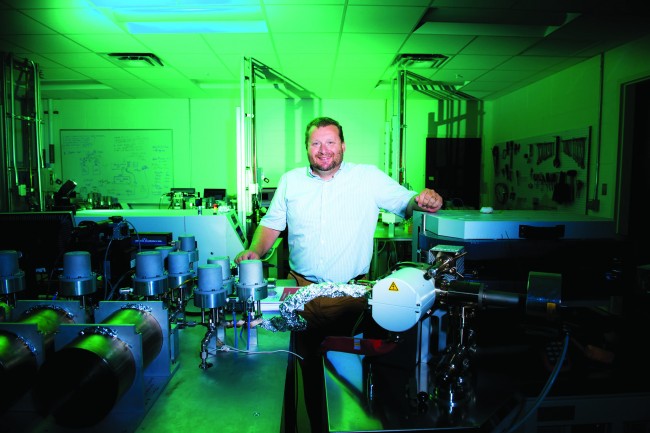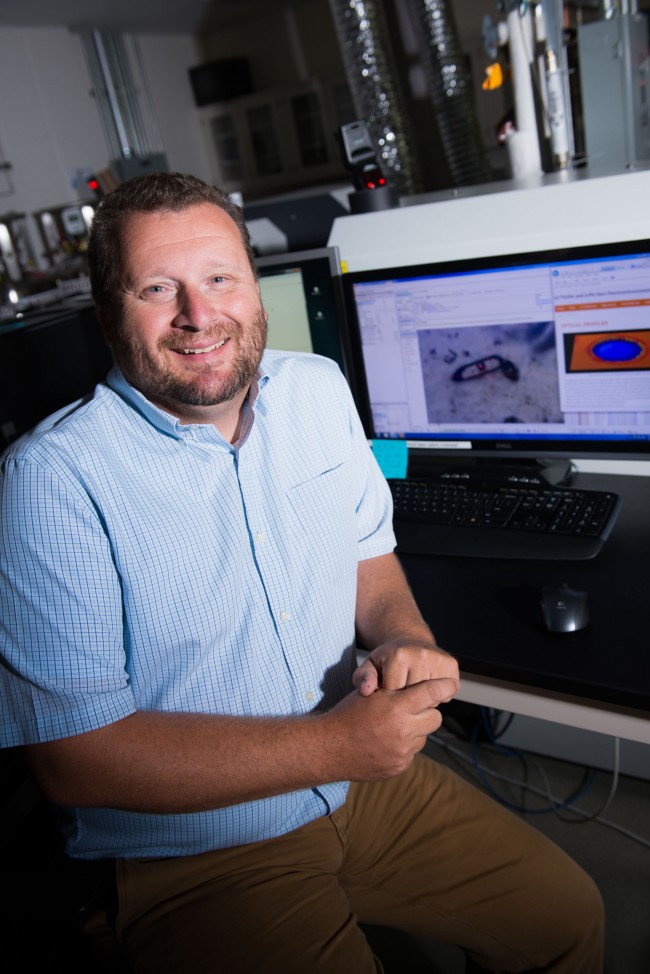The World in a Grain of Sand
October 22, 2014
Daniel Stockli is using zircons to reconstruct past worlds
By Melissa Weber

Over the quiet thrum of mass spectrometers and various lasers in a lab at the University of Texas at Austin, professor Daniel Stockli carefully aims a laser at a zircon no thicker than a human hair. The tiny mineral is one of 120,000 that he and his research team have dated in the past year. Sixty seconds later, the age of this ancient bit of Earth is revealed: 750 million years old.
But that’s just the first step in revealing this little zircon’s storied life.
“A fair number of people do uranium-lead dating on zircon, so the question we had to ask was, ‘Can we do more? How much history can we tease out of a grain of sand?’ ” said Stockli, a professor and researcher in the Department of Geological Sciences at the Jackson School of Geosciences.
Using a unique combination of methods on a single zircon, Stockli’s lab is piecing together a more complete look into the past than simply assigning the crystal an age. Such insights can help scientists reconstruct what the mountain belts and ancient river systems once looked like and how they interacted, how many years mountains existed before being washed to sea, and how each zircon likely reached its current resting spot.
Knowing the genealogy of a zircon grain could be helpful to oil companies that want to know the size and quality of sand bodies. Pinpointing what controls an area’s thermal maturation is also valuable in energy exploration, because organic matter must heat to the right temperature to produce oil and gas.
Zircons are the earth’s biographers. These nearly indestructible crystals contain a record of how tectonics, climate, river drainage systems, basins and coastal processes have worked together over eons across the globe. Stockli’s collection of zircons comes from places like Greece, the Swiss Alps and Iraqi Kurdistan.
But zircons are also tightlipped—so to figure out how long ago a zircon cooled and where it came from, Stockli has to tap into the zircon’s helium supply.
He uses the uranium-thorium-helium method to determine the mineral’s cooling age. As a zircon-containing rock makes its way up through the earth’s crust, the temperature drops. For a zircon, the crystal structure closes at a depth of around 6 kilometers when the rock hits about 180 degrees Celsius. That’s when helium—a byproduct of the radioactive decay of uranium and thorium—starts to accumulate inside the zircon.
“The interesting thing is that with thermal chronology you’re learning something about the tectonic or erosional activity in the hinterland,” Stockli said. “You learn, did this zircon cool and come up quickly? Or did it sit around and do nothing for a long time.”
At the Llano Uplift—the geologic dome in Central Texas where that 750-million-year-old zircon was found—Stockli said rocks have been bobbing up and down near the surface for millions of years.
“That’s a long time to be basically in the upper crust without eroding, without being deeply reburied,” he said. “It’s a place that for some reason has been very stable.”
A zircon carries somewhat of a geochemical signature from its origins. That is what allows scientists to trace grains found in the Gulf of Mexico back to the rocks in Montana from which they eroded. For Stockli, drilling into a zircon and pulling out its trace elements reveals more about the environment in which the crystal formed. In the past year, his lab has analyzed the cooling history and geochemistry of about 7,000 zircons.

“The geochemistry tells us about its family history—what kind of rock it crystallized in—whereas the cooling temperature tells us more about its life history, and the crystallization age tells us about its absolute age,” said Stockli, whose lab is one of few in the world looking at all three pieces of data in a single zircon.
To hear Stockli tell it, dating a billion-year-old zircon is actually pretty simple. So he developed a technique with a colleague from the University of California–Los Angeles that involves combined uranium-thorium using an ion microprobe and his uranium-thorium-helium method to date zircons as young as 2,000 years old, a method with applications in archeology and volcanic hazards. For very young minerals—between 1,000 and 100,000 years old—dating becomes analytically difficult.
Yet with this new technique, his lab is now dating zircons found in ashes interlayered with archaeological deposits found in the Mediterranean and in Mesoamerica, once home to the Mayans and Aztecs.
They’re also analyzing zircons found among anthropological remains in Europe, where a series of volcanic eruptions about 40,000 years ago appear to mark the end of the Neanderthals.
“Zircons can tell you much more than just their age,” said Stockli. “It’s amazing how much information they retain. They’re like ancient time capsules.”
Back to the Newsletter